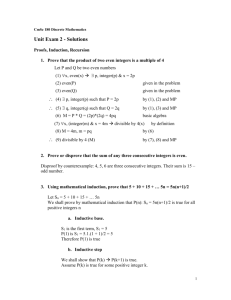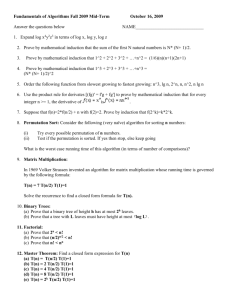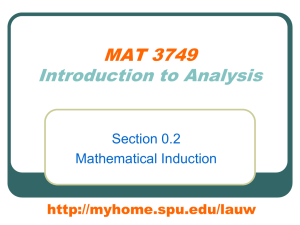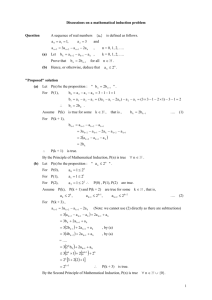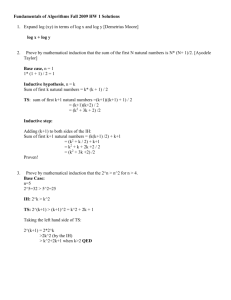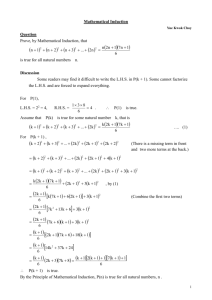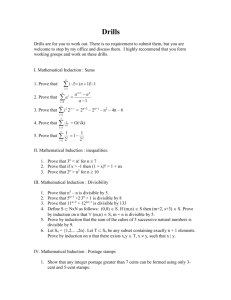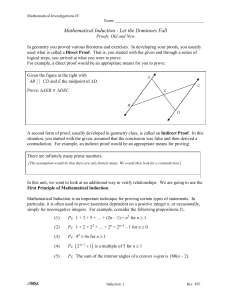inductional potpourri!
advertisement
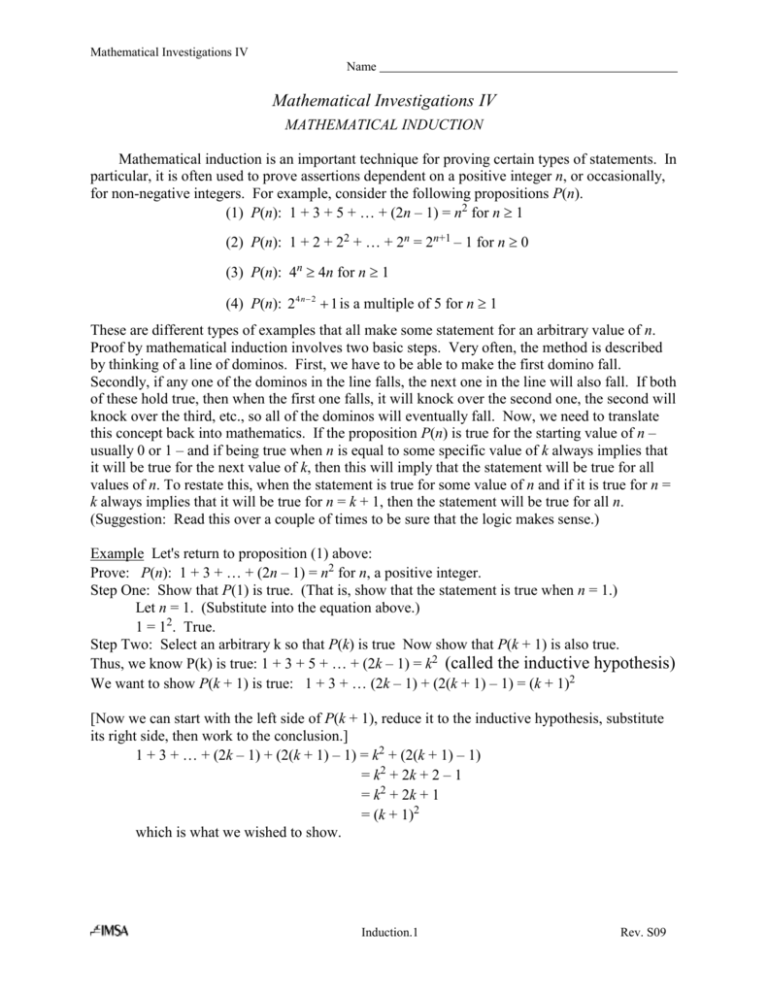
Mathematical Investigations IV Name Mathematical Investigations IV MATHEMATICAL INDUCTION Mathematical induction is an important technique for proving certain types of statements. In particular, it is often used to prove assertions dependent on a positive integer n, or occasionally, for non-negative integers. For example, consider the following propositions P(n). (1) P(n): 1 + 3 + 5 + … + (2n – 1) = n2 for n 1 (2) P(n): 1 + 2 + 22 + … + 2n = 2n+1 – 1 for n 0 (3) P(n): 4n 4n for n 1 (4) P(n): 24n 2 1 is a multiple of 5 for n 1 These are different types of examples that all make some statement for an arbitrary value of n. Proof by mathematical induction involves two basic steps. Very often, the method is described by thinking of a line of dominos. First, we have to be able to make the first domino fall. Secondly, if any one of the dominos in the line falls, the next one in the line will also fall. If both of these hold true, then when the first one falls, it will knock over the second one, the second will knock over the third, etc., so all of the dominos will eventually fall. Now, we need to translate this concept back into mathematics. If the proposition P(n) is true for the starting value of n – usually 0 or 1 – and if being true when n is equal to some specific value of k always implies that it will be true for the next value of k, then this will imply that the statement will be true for all values of n. To restate this, when the statement is true for some value of n and if it is true for n = k always implies that it will be true for n = k + 1, then the statement will be true for all n. (Suggestion: Read this over a couple of times to be sure that the logic makes sense.) Example Let's return to proposition (1) above: Prove: P(n): 1 + 3 + … + (2n – 1) = n2 for n, a positive integer. Step One: Show that P(1) is true. (That is, show that the statement is true when n = 1.) Let n = 1. (Substitute into the equation above.) 1 = 12. True. Step Two: Select an arbitrary k so that P(k) is true Now show that P(k + 1) is also true. Thus, we know P(k) is true: 1 + 3 + 5 + … + (2k – 1) = k2 (called the inductive hypothesis) We want to show P(k + 1) is true: 1 + 3 + … (2k – 1) + (2(k + 1) – 1) = (k + 1)2 [Now we can start with the left side of P(k + 1), reduce it to the inductive hypothesis, substitute its right side, then work to the conclusion.] 1 + 3 + … + (2k – 1) + (2(k + 1) – 1) = k2 + (2(k + 1) – 1) = k2 + 2k + 2 – 1 = k2 + 2k + 1 = (k + 1)2 which is what we wished to show. Induction.1 Rev. S09 Mathematical Investigations IV Name Alternatively, we can start with the statement P(k) since we know it is true and add the next term, 2(k + 1) – 1, to both sides of the equation. Then simplify and factor on the right to obtain the right side of P(k + 1), the statement that we wish to show.] 1 + 3 + … + (2k – 1) = k2 1 + 3 + … + (2k – 1) + (2(k + 1) – 1) = k2 + (2(k + 1) – 1) = k2 + 2k + 2 – 1 = k2 + 2k + 1 = (k + 1)2 which is what we wished to show. Therefore, 1 + 3 + … + (2n – 1) = n2 is true for all positive integers n. 2. Prove proposition (2) P(n): 1 + 2 + 22 + … + 2n = 2n+1 – 1 for n 0. Step One: Show that this is true for n = 0. Step Two: To begin, we select an arbitrary k so that P(k) is true: P(k): We wish to prove: P(k + 1): Now, proceed as in Example 1. Induction.2 Rev. S09 Mathematical Investigations IV Name n n(n 1) In S&S we derived the formula P(n): Sn j 3 for n 1. 2 j 1 It's now time to prove this statement. Step One: Show that this statement is true for n = 1. 2 3. Step Two: We select an arbitrary k so that P(k) is true: P(k): We wish to prove: P(k + 1) is true. P(k + 1): Now prove the statement. Induction.3 Rev. S09 Mathematical Investigations IV Name 4. Prove: P(n): 3 + 7 + 11 + … + (4n – 1) = n (2n + 1) for n 1. Step One: Step Two: Select an arbitrary k so that P(k) is true. P(k): We want to prove P(k + 1) is true P(k + 1): Induction.4 Rev. S09 Mathematical Investigations IV Name Now we'll return to examples (3) and (4) that were given on page 1. 5. Prove P(n): 4n 4n for n 1. (Follow the basic procedure from previous problems. [Hint: at the end of these sheets. Try to solve the problem before looking at the hint.] Induction.5 Rev. S09 Mathematical Investigations IV Name 6. Prove P(n): 24n 2 1 is a multiple of 5 for n 1. Let's look at this problem in two ways. a. With your calculator, evaluate this expression for several values of n to see if it seems reasonable. Enter: 2^(4n – 2) + 1 | n = 1 Fill in the table using the given values of n. Then choose two of your own values to extend the table. n 1 value Are all of the values that you found divisible by 5? How do you know? 2 12 43 ___ ___ Your TI-89 will rewrite the expression, giving 24n 2 1 = Does this form help? Can you see that this is divisible by 5? . b. Proof time. We've seen that 24n 2 1 is divisible by 5 when n = 1. What expression must also be shown to be divisible by 5? Take this expression and separate it into the two blanks below. 24 is added and subtracted as indicated. _______________ 2 2 4 4 _________ Factor 24 out of the first group of two terms. Continue the proof. (Show that both expressions in parentheses are divisible by 5, and such, so is their sum.) Induction.6 Rev. S09 Mathematical Investigations IV Name 7. Prove: x – 1 divides xn – 1. a. First use your TI-89 to explore this statement for several values of n. Write two of these division statements below with the results. b. What is the statement that we need to prove? c. In order to do the proof, you can subtract and add (for a net addition of 0) and continue in a manner similar to that in the previous problem. Complete the proof. Induction.7 Rev. S09



